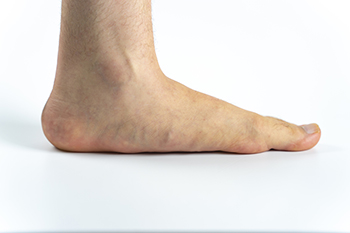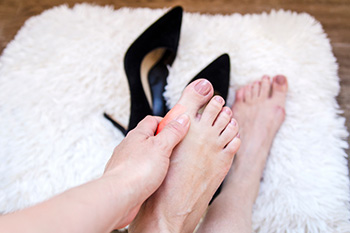Items filtered by date: April 2022
Do I Have Flat Feet?

The medical term for fallen arches or flat feet is known as pes planus. It is noticeable when the foot lies flat on the floor, and the arch is absent. Some patients do not have symptoms, or may experience mild pain or achiness in different parts of the leg. Most people are born with flat feet, and the arch generally forms in the teenage years. This condition may develop from genetic reasons, obesity, or possibly from a foot injury. Additionally, a dysfunction of one or more of the muscles in the foot may lead to flat feet. It is beneficial for patients who have flat feet to wear shoes that are supportive, and this may help to prevent future injuries. People who have flat feet are advised to consult with a podiatrist who can offer custom-made orthotics for relief.
Flatfoot is a condition many people suffer from. If you have flat feet, contact one of our podiatrists from William Street Podiatry. Our doctors will treat your foot and ankle needs.
What Are Flat Feet?
Flatfoot is a condition in which the arch of the foot is depressed and the sole of the foot is almost completely in contact with the ground. About 20-30% of the population generally has flat feet because their arches never formed during growth.
Conditions & Problems:
Having flat feet makes it difficult to run or walk because of the stress placed on the ankles.
Alignment – The general alignment of your legs can be disrupted, because the ankles move inward which can cause major discomfort.
Knees – If you have complications with your knees, flat feet can be a contributor to arthritis in that area.
Symptoms
- Pain around the heel or arch area
- Trouble standing on the tip toe
- Swelling around the inside of the ankle
- Flat look to one or both feet
- Having your shoes feel uneven when worn
Treatment
If you are experiencing pain and stress on the foot you may weaken the posterior tibial tendon, which runs around the inside of the ankle.
If you have any questions please feel free to contact one of our offices located in William Street in New York, NY, Forest Hills, NY, and Broadway in New York, NY . We offer the newest diagnostic and treatment technologies for all your foot and ankle needs.
It's Time for Beautiful Feet
Finding Shoes That Provide Bunion Relief
Bunions, which are bumps on the big toe caused by the misalignment of the bones, can be aggravated by your choice in footwear. In fact, many types of shoes, such as high heels, either have a role in forming a bunion or make it worse if you have one. For smaller bunions, finding a comfortable shoe may be as simple as finding one with a roomier toe box, in both width and height; wearing a slightly larger shoe size; or choosing a lower heel. These measures give the toes a bit more room and reduce the squeezing of the big toe and lesser toes that can be extremely painful as well as further misaligning the bones of the foot. In addition, a shoe with more depth allows for orthotics to be added, if the bunion has already caused pressure and pain in the ball of the foot. Shoes should be wide enough for the toes to move around and have a soft sole for extra cushioning. The outer part of the shoe can be made of mesh or other flexible material that molds to the shape of bunion, rather than pressing against it. If you need guidance in finding the right shoe to accommodate bunions, please make an appointment with a podiatrist for guidance.
It is important to find shoes that fit you properly in order to avoid a variety of different foot problems. For more information about treatment, contact one of our podiatrists from William Street Podiatry. Our doctors will treat your foot and ankle needs.
Proper Shoe Fitting
Shoes have many different functions. They cushion our body weight, protect our feet, and allow us to safely play sports. You should always make sure that the shoes you wear fit you properly in order to avoid injuries and deformities such as: bunions, corns, calluses, hammertoes, plantar fasciitis, stress fractures, and more. It is important to note that although a certain pair of shoes might be a great fit for someone else, that doesn’t mean they will be a great fit for you. This is why you should always try on shoes before buying them to make sure they are worth the investment. Typically, shoes need to be replaced ever six months to one year of regular use.
Tips for Proper Shoe Fitting
- Select a shoe that is shaped like your foot
- Don’t buy shoes that fit too tight, expecting them to stretch to fit
- Make sure there is enough space (3/8” to ½”) for your longest toe at the end of each shoe when you are standing up
- Walk in the shoes to make sure they fit and feel right
- Don’t select shoes by the size marked inside the shoe, but by how the shoe fits your foot
The shoes you buy should always feel as good as they look. Shoes that fit properly will last longer, feel better, and improve your way of life each day.
If you have any questions, please feel free to contact one of our offices located in William Street in New York, NY, Forest Hills, NY, and Broadway in New York, NY . We offer the newest diagnostic and treatment technologies for all your foot care needs.
Several Causes of Heel Pain
Heel pain can develop for a variety of reasons that can include plantar fasciitis, heel spurs, Sever’s disease, or an Achilles tendon injury. Many patients with heel pain can manage it when comfortable shoes are worn that have a low heel. Additionally, it is beneficial to practice specific stretches that can help heel pain. An effective stretch is defined as standing on a step and lowering one heel at a time until a gentle pull is felt. It may feel good to roll the bottom of the foot on a tennis ball, and this may help the entire foot to feel good. It is suggested to refrain from wearing high heels or shoes that are pointy, in addition to refraining from standing for long periods of time. If you have heel pain, it is strongly advised that you contact a podiatrist who can determine what the cause may be and begin the correct treatment.
Many people suffer from bouts of heel pain. For more information, contact one of our podiatrists of William Street Podiatry. Our doctors can provide the care you need to keep you pain-free and on your feet.
Causes of Heel Pain
Heel pain is often associated with plantar fasciitis. The plantar fascia is a band of tissues that extends along the bottom of the foot. A rip or tear in this ligament can cause inflammation of the tissue.
Achilles tendonitis is another cause of heel pain. Inflammation of the Achilles tendon will cause pain from fractures and muscle tearing. Lack of flexibility is also another symptom.
Heel spurs are another cause of pain. When the tissues of the plantar fascia undergo a great deal of stress, it can lead to ligament separation from the heel bone, causing heel spurs.
Why Might Heel Pain Occur?
- Wearing ill-fitting shoes
- Wearing non-supportive shoes
- Weight change
- Excessive running
Treatments
Heel pain should be treated as soon as possible for immediate results. Keeping your feet in a stress-free environment will help. If you suffer from Achilles tendonitis or plantar fasciitis, applying ice will reduce the swelling. Stretching before an exercise like running will help the muscles. Using all these tips will help make heel pain a condition of the past.
If you have any questions please contact one of our offices located in William Street in New York, NY, Forest Hills, NY, and Broadway in New York, NY . We offer the newest diagnostic and treatment technologies for all your foot and ankle needs.
When Is Toe Surgery Needed?
Without healthy toes, it is much more difficult to walk, run or live a normal, active life. Sometimes the toes become injured or damaged in such a way that only surgery can alleviate the problem. The most common reasons for toe surgery are changes in the shape of the toe (bunions, hammertoe, claw toe), pain in the toe joints (arthritis), and pain in the ball of the foot (metatarsalgia). Non-surgical treatment includes padding between the toes to keep them from rubbing against each other, wearing soft shoes that reduce the pain caused by toes rubbing against the top or side, and wearing inserts in your shoes to better cushion them. Surgical treatment includes releasing or strengthening tendons, straightening a toe by removing a bone, and realigning the bones of the toes. If toe pain or deformity is an ongoing problem, it is suggested that you seek guidance from a podiatrist who can examine your toes, diagnose the problem, and formulate a treatment plan that is right for you.
Foot surgery is sometimes necessary to treat a foot ailment. To learn more, contact one of our podiatrists of William Street Podiatry. Our doctors will assist you with all of your foot and ankle needs.
When Is Surgery Necessary?
Foot and ankle surgery is generally reserved for cases in which less invasive, conservative procedures have failed to alleviate the problem. Some of the cases in which surgery may be necessary include:
- Removing foot deformities like bunions and bone spurs
- Severe arthritis that has caused bone issues
- Cosmetic reconstruction
What Types of Surgery Are There?
The type of surgery you receive will depend on the nature of the problem you have. Some of the possible surgeries include:
- Bunionectomy for painful bunions
- Surgical fusion for realignment of bones
- Neuropathy decompression surgery to treat nerve damage
Benefits of Surgery
Although surgery is usually a last resort, it can provide more complete pain relief compared to non-surgical methods and may allow you to finally resume full activity.
Surgical techniques have also become increasingly sophisticated. Techniques like endoscopic surgery allow for smaller incisions and faster recovery times.
If you have any questions please feel free to contact one of our offices located in William Street in New York, NY, Forest Hills, NY, and Broadway in New York, NY . We offer the newest diagnostic and treatment technologies for all your foot and ankle needs.





